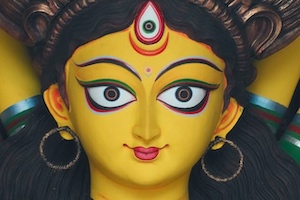How this Kolkata Durga Puja pandal evokes Palestine — through the lens of 1943 Bengal famine
Indian Express | 18 September 2025Written by Anisha Ghosh
A Durga Puja pandal in South Kolkata this year has thrown spotlight on the suffering, pain and hunger in Palestine and has connected that with the Bengal famine which shook the nation 82 years ago.
The Behala Friends puja committee’s theme this year is titled ‘Nabanna’, a celebration of harvesting.
The theme has been designed by renowned artist Pradip Das, who said, “What makes this year’s effort particularly moving is its global connection. Naama Hassan, a Palestinian poet, writer, and social worker from Rafah in the Gaza Strip, is now displaced with her seven children, living in a tent in Al-Mawas. Her poem, written for ‘Nabanna’, was recited in Kolkata by Palestinian theatre director and actress Raeda Ghazaleh, whose career spans Palestine, Europe, and the United States.”
The poem reads, “I indulge my hunger/I imitated a spike of wheat/in its dance/I kissed the mouth of a bird/that visits my arbor each morning/yet I could not become a loaf/Bread has its own rituals/long exhausted from the land”.
“Hassan resists war through writing and art, documenting survival, fear, and resilience. Hassan has published Be Gaza Yourself: War Memoirs, the novel It Was Not Death, the poetry collection Letters by an Active Agent, and Where the Flame Danced, The Last Butterfly in Swedish. Her work has appeared internationally in journals such as Harvard Magazine, Muzna, and others in Arabic, French, Italian, and English. Ghazaleh co-founded Inad Theatre and Al-Harah Theatre in Beit Jala, and has directed and acted in numerous stage and screen productions. She recently established Masahati, an independent creative space for displaced artists,” Das said.
Along with Hassan’s poetry, the theme has used poems that emerged during the Bengal famine, like Sukanta Bhattacharya’s “Hey Mahajibon (O Great Life)” and “Proyojon nei Kobitar Snigdhota (There is no need for poetry’s gentleness)”.
According to Das, “Today in Gaza, families face bombings, starvation, and the destruction of homes, and the same urgency resounds: poetry cannot remain mere lyrical beauty but must transform into the language of protest. When Gazans say, ‘people of Gaza do not fear death anymore, fear not being remembered’, they echo Sukanta’s conviction that where the fear of death ends, revolution begins. Just as famine-struck Bengalis once looked at the full moon as if it were bread, so too do the hungry eyes of Gaza’s children see survival rather than serenity in that same moon.”
Bhaskar Saha, a member of the puja committee said, “Across decades and continents, ‘Hey Mahajibon’ reminds us that whenever innocent people are crushed under the weight of war, hunger, or politics, art must rise beyond aesthetics to become a weapon and witness. Whether in Bengal’s famine or Gaza’s rubble, the poem insists that beauty must give way to truth, and truth must strike like a hammer to awaken the world.”
Saha said, “To remember the famine is not only to grieve but to resist. It is to ensure that the narrative of exploitation and plunder does not vanish beneath the weight of official silence. It is to connect Bengal of 1943 with Gaza today, with Yemen, Sudan, and every land where people starve amidst plenty. To hold onto this memory is to ask: have we learned anything yet?”
(Anisha Ghosh is an intern with The Indian Express)
